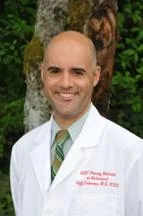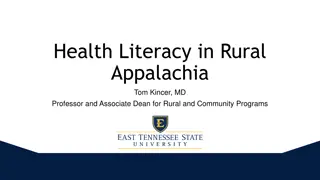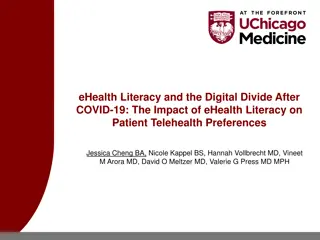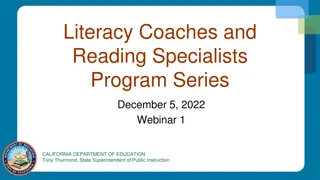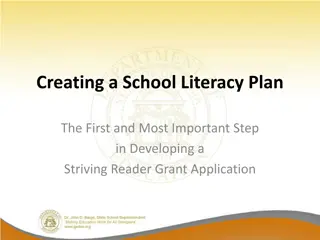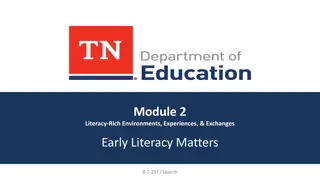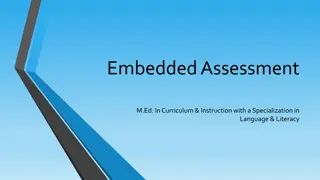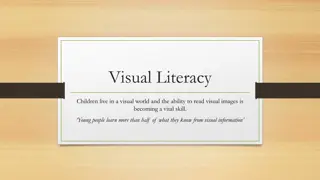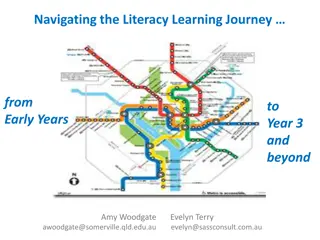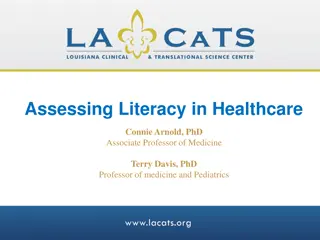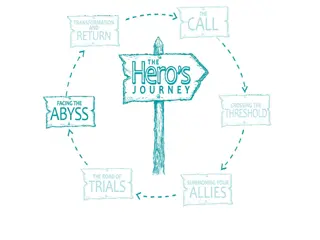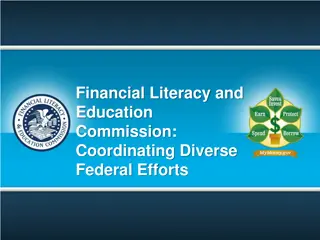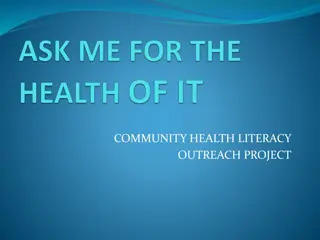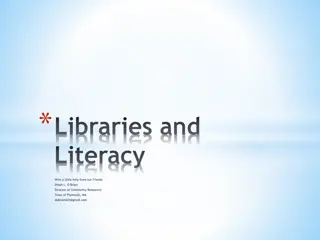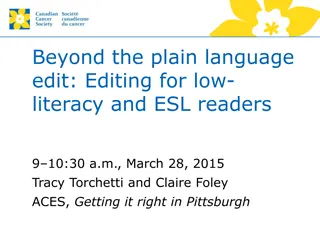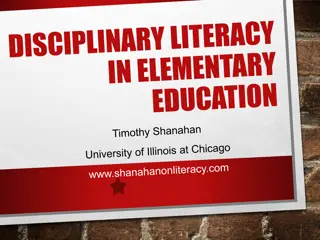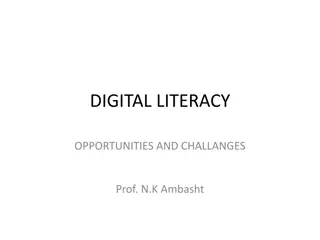Measurable Health Literacy Best Practices for Professionals
Set measurable health literacy best practices for health professionals, identify educational competencies, and understand their role in training curricula design. Explore consensus study design, best practice wording, limitations, and opportunities in health literacy education.
Uploaded on Feb 18, 2025 | 0 Views
Download Presentation

Please find below an Image/Link to download the presentation.
The content on the website is provided AS IS for your information and personal use only. It may not be sold, licensed, or shared on other websites without obtaining consent from the author.If you encounter any issues during the download, it is possible that the publisher has removed the file from their server.
You are allowed to download the files provided on this website for personal or commercial use, subject to the condition that they are used lawfully. All files are the property of their respective owners.
The content on the website is provided AS IS for your information and personal use only. It may not be sold, licensed, or shared on other websites without obtaining consent from the author.
E N D
Presentation Transcript
Cliff Coleman, MD, MPH Assistant Professor Department of Family Medicine Oregon Health & Science University colemanc@ohsu.edu 2013 Wisconsin Health Literacy Summit: Changing Systems, Changing Lives April 9, 2013
Communication works for those who work at it -- John Powell, composer
Funding support: National Cancer Institute grants number 5K07 CA121457-05 and 3K07 CA121457 04S2 (Behavioral & Social Sciences as Core Elements of the Medical School Curriculum) Health Resources and Services Administration grant number 1D58 HP15234 01-00 (Curriculum Activities for Learning Mood Disorders and Community Approaches to Residency Education (CALM CARE))
1. Describe a set of measurable health literacy best practices for health professionals. 2. Identify the educational competencies which underpin health literacy best practices. 3. Understand how health literacy competencies and best practices can be used in the design and implementation of training curricula for health professionals.
Background: why a consensus study? Consensus study design and results Examination of selected best practices Practical applications Best practice wording Associated educational competencies Limitations, opportunities, and next steps
Health professionals and staff have limited education, training, continuing education, and practice opportunities to develop skills for improving health literacy Professional schools and professional continuing education programs in health and related fields, including medicine, dentistry, pharmacy, social work, anthropology, nursing, public health, and journalism, should incorporate health literacy into their curricula and areas of competence (Neilsen-Bohlman et al, 2004, p161)
Health professionals generally lack adequate health literacy awareness, knowledge, and skills Many best practices for effective communication with low health literacy patients are not routinely used by physicians (Coleman, 2011)
Increasing calls for improving training about health literacy for health professionals Proliferation of HL curricula for health professionals HL curricula can positively influence learners knowledge, skills and attitudes (Coleman, 2011)
At least 30% of U.S. medical schools are not teaching about health literacy (Coleman & Appy, 2012) Less than half of Family Medicine residency programs are teaching about health literacy (Coleman & Nguyen, unpublished) Little known about other health professions
No published guidelines for the recommended content or structure of health literacy curricula for health professionals Very little empiric data to inform what to teach, or how and when to teach it (Coleman, 2011)
The knowledge, skills and attitudes which health professionals need in order to address low health literacy among consumers of health care and health information (Coleman, Hudson & Maine, Unpublished)
Patient-centered protocols and strategies to minimize the negative consequences of low or limited health literacy (Barrett et all, 2008)
Literature review (2010) yielded a diverse array of recommendations (i.e., best practices ) 24 Knowledge items 28 Skill items 11 Attitude items Competencies 32 Practice items Some overlap between domains
Specific Aim: To develop a consensus agreement on a common set of core health literacy competencies for U.S. health professions school graduates
Design: Modified Delphi consensus process A commonly used method to capture expert opinions of groups Useful when empiric evidence is lacking Use is well described in healthcare competencies work Modified in that the panel met in person initially
Identify proposed competencies (literature review) Convene expert panel Individuals anonymously rate their agreement with items on the list Predetermined levels of agreement Facilitated group discussion helps move the needle on items prior to re-rating Participants opinions important Modifications suggested Process stops when diminishing returns reached
Translating best practices into measurable competencies 3 examples Best practice Domain(s) Competency. The learner Knows which kinds of words, phrases, or concepts may be jargon to patients Operationalization. The learner Selects jargon words from a list Explains why jargon terms may be misinterpreted 1. Use common words when speaking to patients Knowledge Skills Practices 2. Speak clearly and at a moderate pace Speech is perceived as appropriate pace, volume and clarity. Speech is always intelligible Skills Practices Demonstrates ability to speak slowly and clearly with patients 3. Confirm patients understand what they need to know and do by asking them to teach back directions Knowledge Skill Practices Routinely uses a tech back or show me technique to check for understanding Confirms patient s understanding by asking patient to explain back in their own words (or show) what they have heard/seen at end of encounter Puts onus on self, by saying I don t always explain things well. Tell me what you ve heard.
Sample: Executive leadership representatives from member organizations of the Federation of Associations of Schools of the Health Professions (FASHP): American Association of Colleges of Nursing American Association of Colleges of Osteopathic Medicine American Association of Colleges of Pharmacy American Dental Education Association Association of Academic Health Centers Association of American Medical Colleges Association of Chiropractic Colleges Association of Schools & Colleges of Optometry Association of Schools of Allied Health Professions Association of Schools of Public Health Association of University Programs in Health Admin National League for Nursing Physician Assistant Education Association Attendees of a 2-day meeting on teaching health literacy to health professions students St Louis, MO, October 2010 Hosted by Health Literacy Missouri and Saint Louis College of Pharmacy
22 FASHP participants Age, mean (n=22) Female (n = 21) White Non-Hispanic Years in health professions education, mean (n = 22) Background in direct patient care (n = 21) Highest level of education attained (n= 20) Bachelor s Master s Doctorate Would your peers consider you to have expertise on the topic of health literacy? (n = 22) YES NO 51.9 years 15 (71.4 %) 21 (95.5%) 21 (95.5%) 19.1 years 19 (90.5%) 1 (5%) 1 (5%) 18 (90%) 16 (72.7%) 6 (27.3%)
62 competencies and 32 best practices accepted after 4 rounds Round One Round Two Round Three Round Four Total Accept ed 19/24 5/5 -/- 24/24 Knowledge Items -/- Competencies 21/28 2/4* 2/3 27/29 Skills Items 2/3 11/11 -/- -/- 11/11 Attitude Items -/- 2/3 2/3 62/64 51/63 7/9 Competencies Total 0/1 32/33 26/32 4/6 2/3** Practice Items 77/95 11/15 4/6 94/97 Total 2/3
Spoken communication: 1) Focus on 1-3 key need-to-know items 2) Avoid medical jargon 3) Elicit questions in a patient-centered manner 4) Assess understanding using teach back
Example 1. Focus on 1-3 key need-to-know items Patients typically retain < 50% of information Illness and stress are major barriers to learning Focus on what patients need to do, not on facts Provides action-oriented knowledge Arrange for follow-up to add new information (Sheridan et al, 2011; Schwartzberg et al, 2007; AMA, 1999)
Example 1. Focus on 1-3 key need-to-know items Best Practice: Routinely emphasizes one to three need-to-know or need-to-do concepts during a given patient encounter (P10) Underlying Competencies: Knows that patients learn best when a limited number of new concepts are presented at any given time (K19) Demonstrates ability to emphasize one to three need-to- know or need-to-do concepts during a given patient encounter (S22) (P=practice, K=knowledge, S=skills, A=attitudes)
Example 2. Avoid medical jargon Even experienced clinicians use jargon (Castro et al, 2007) Research shows that all patients prefer simple plain language health information (AMA, 1999) Define and teach important unavoidable jargon (e.g., hemoglobin A1c )
But jargon is complex! Words Phrases Concepts Numeracy Obvious or subtle Unfamiliar Misunderstood Misinterpreted Type of Jargon Description Examples Words Phrases Concepts Technical Words, phrases or concepts with meaning only in a clinical context Glucometer Cardiologist Insomnia Abdomen Cath lab Ortho Acronyms: GERD COPD UTI Follow-up Referral Chronic PRN PCP Contagous Risk Quantitative Words, phrases or concepts requiring clinical judgment or knowledge Unlikely Increased Tablespoon Fever Excessive wheezing Twice daily Lay Words, phrases or concepts with two or more meanings or interpretations, one of which is medical Stable Abnormal Stool Frequency Salt Idioms: Come down with Break out Run a fever Metaphors: ?
Example 2. Avoid medical jargon Best Practice: Consistently avoids using medical jargon in oral and written communication with patients, and defines unavoidable jargon in lay terms (P14) Underlying Competencies: Knows which kinds of words, phrases, or concepts may be jargon to patients (K5) Demonstrates ability to use common familiar lay terms, phrases and concepts, and appropriately define unavoidable jargon, and avoid using acronyms in oral and written communication with patients (S1) Demonstrates ability to recognize, avoid and/or constructively correct the use of medical jargon, as used by others in oral and written communication with patients (S2) (P=practice, K=knowledge, S=skills, A=attitudes)
Example 3. Elicit questions in a patient-centered manner No: Do you have any questions? Implies that you expect them to get it (if they don t, something must be wrong with them ) Patients do not answer this honestly Yes: What questions do you have? Implies an expectation that patients should have questions! (DeWalt et al, 2010)
Example 3. Elicit questions in a patient-centered manner Best Practice: Consistently elicits questions from patients through a patient-centered approach [e.g., what questions do you have? , rather than do you have any questions? ] (P24) Underlying Competencies: Demonstrates ability to effectively elicit questions from patients through a patient-centered approach (e.g., asks what questions do you have? rather than do you have any questions? ) (S19) (P=practice, K=knowledge, S=skills, A=attitudes)
Example 4. Assess understanding using teach back Stop asking, do you understand? Implies that patients shouldunderstand (if they don t, something must be wrong with them ) Start using a Teach Back or show me technique Ask patient to explain back what they are going to do. Say I want to make sure I have explained things well. Please tell me in your own words how you are going to use this medicine. Ask how would you tell a friend to take this medicine? Show me how you use this inhaler. (DeWalt et al, 2010; NQF, 2008; Schillinger et al, 2003)
Video http://www.nchealthliteracy.org/teachingaids.html
Example 4. Assess understanding using teach back Best Practice: Routinely uses a teach back or show me technique to check for understanding and correct misunderstandings in a variety of health care settings (P29) Underlying Competencies: Knows the rationale for and mechanics of using a teach back or show me technique to assess patient understanding (K23) Demonstrates effective use of a teach back or show me technique for assessing patients understanding (S15) Expresses the attitude that every patient has the right to understand their health care, and that it is the health care professional s duty to elicit and ensure patients best possible understanding of their health care (A9) (P=practice, K=knowledge, S=skills, A=attitudes)
Written communication: 1) Select written materials at 5th-6th grade level 2) Write for easy understanding
Example 1. Select written materials at 5th-6th grade level The average US adult reads at an 8th grade level (Kutner et al, 2005) Over 1500 studies show that health information is typically written well above the average reading level! (Rima Rudd, 3rd Annual Health Literacy Research Conference, 10/18/11) Most patients will not understand the majority of the educational handouts, consent forms, medical-history questionnaires, and insurance papers they receive (Weiss & Coyne, 1997)
Example 1. Select written materials at 5th-6th grade level Best Practice: Consistently locates and uses literacy-appropriate patient education materials, when needed and available, to reinforce oral communication, and reviews such materials with patients, underlining or highlighting key information (P27) Underlying Competencies: Knows that the average US adult reads at an 8th-9th grade reading level, but that most patient education materials are written at a much higher reading level (K7) Demonstrates ability to recognize plain language principles in written materials produced by others (S4) (P=practice, K=knowledge, S=skills, A=attitudes)
Example 2. Write for easy understanding Content Format State the purpose Plain jargon-free language 1-2 syllable words 5th-6th grade level Need-to-know info first Focus on action items Lots of white space Subject headings Short simple sentences Bulleted lists 12-point font or larger Serif-style font Reinforcing pictures Use an online health literacy style manual: How to Write Easy-to- Read Health Materials http://www.nlm.nih.gov/medlineplus/etr.html Test your product before distribution (Doak et al, 1996)
April 16, 2010 Dear _________ Your bloodwork is unremarkable without any signs to suggest parasitic infection, inflammation of blood vessels or other problems. I suspect your symptoms are functional in nature and not due to a specific disease process. I doubt that further testing would be productive. You may want to consider getting a second opinion and I would be happy to assist in arranging one. Please let me know if I can be of help in that regard. Sincerely, ___________, MD
April 16, 2010 Dear _________ Your bloodwork is unremarkable without any signs to suggest parasitic infection, inflammation of blood vessels or other problems. I suspect your symptoms are functional in nature and not due to a specific disease process. I doubt that further testing would be productive. You may want to consider getting a second opinion and I would be happy to assist in arranging one. Please let me know if I can be of help in that regard. Sincerely, Years of formal education Needed to easily understand this text = 10.8 ___________, MD (http://www.editcentral.com)
April 16, 2010 Dear _________ Your blood test was normal. I think your symptoms are not due to a specific disease. I do not think that more tests will help. You may want to get a second opinion from another doctor. I would be happy to help set that up. Please let me know if I can be of help with that. Sincerely, ___________, MD Years of formal education Needed to easily understand this text = 5.9 (http://www.editcentral.com)
Example 2. Write for easy understanding Best Practices: Consistently follows principles of easy-to-read formatting when writing for patients (P15) Routinely writes in English at approximately the 5th-6th grade reading level (P17) Consistently avoids using medical jargon in oral and written communication with patients, and defines unavoidable jargon in lay terms (P14) Underlying Competencies: Knows best practice principles of plain language and clear health communication for oral and written communication (K18) Demonstrates ability to follow best-practice principles of easy-to-read formatting and writing in written communication with patients (S3) Demonstrates ability to write in English at approximately the 5th-6th grade reading level (S6) (P=practice, K=knowledge, S=skills, A=attitudes)
The 32 identified practices, and 62 underlying competencies are not in rank order Validated measurement tools do not exist for assessing the practices and underlying competencies
For the first time we have a comprehensive list of health literacy practices Practices and competencies are theoretically measurable Individuals and organizations can use the list as a menu of options
Consensus group with health literacy experts to prioritize items Empiric studies tracking patient-centered outcomes of health literacy training interventions for health professionals
Communication works for those who work at it -- John Powell, composer
Ali N. Are we training residents to communicate with low health literacy patients? Journal of Community Hospital Internal Medicine Perspectives 2012, 2: 19238 - http://dx.doi.org/10.3402/jchimp.v2i4.19238. Accessed 4/1/13 AMA (American Medical Association), Ad Hoc Committee on Health Literacy for the Council on Scientific Affairs. Health literacy: report of the Council on Scientific Affairs. JAMA 1999; 281(6):552-7 Barrett SE, Puryear JS, Westpheling K. Health literacy practices in primary care settings: examples from the field. January 2008. Available at http://www.commonwealthfund.org Castro CM, Wilson C, Wang F, Schillinger D. Babel Babble: Physicians use of unclarified medical jargon with patients. Am J Health Behav 2007;31(Suppl 1):S85-S95
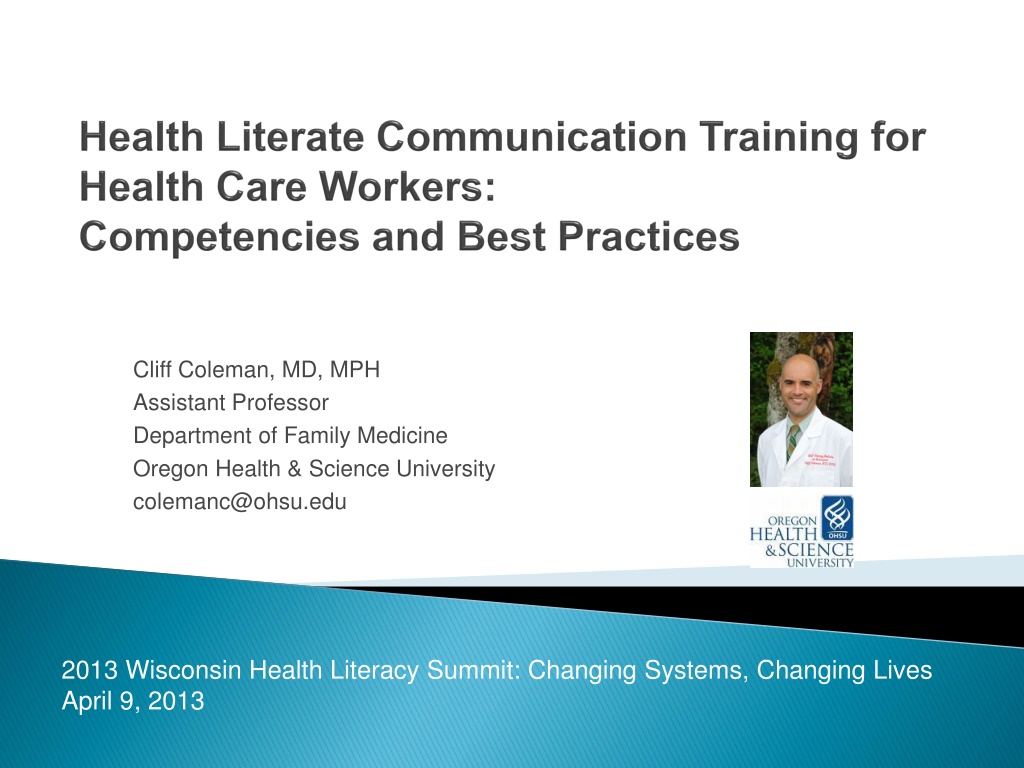
 undefined
undefined

